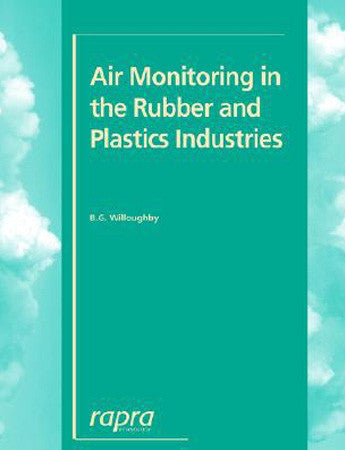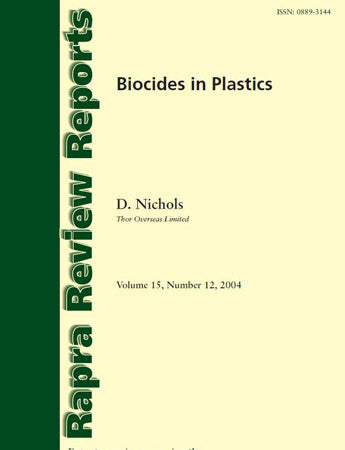Air Monitoring in the Rubber and Plastics Industries
Health, safety, and the environment are key driving factors in the industry in the 21st Century. Monitoring of exposure to chemicals in the workplace and in emissions from factories is used to calculate exposure to possible chemical toxins including carcinogens. Other factors must also be considered in chemical monitoring, such as the actual risk of harm and possible areas of high exposure, such as when opening ovens or dealing with equipment problems, situations where a build-up of the chemical can occur in an enclosed environment.
Different types of monitoring equipment and ways of monitoring are available. For example, static monitoring can be carried out in one place over a period of time, or a recorder can be placed on an employee near to the breathing zone to measure individual exposure to chemicals. There are many factors which can lead to inaccurate interpretation of results from using equipment which does not distinguish between critical chemicals or which is not sufficiently sensitive, to not taking into account local factors such as employee's smoking habits.
To measure a chemical in air, it must first be trapped in some way and the trapped sample analysed. There are different methods of trapping from simple grab sampling of air to the use of filters, absorbents, and adsorbents. The trapped sample must be analysed and a variety of methods are available. Chemicals present at low levels can still be toxic. The aim is to choose a method that is capable of measuring across the range of exposure levels of concern. Government bodies such as NIOSH and OSHA in the USA and the HSE in the UK have published approved methods for specific chemical species.
There are many chemicals in use in the rubber and plastics industries from the monomers polymerised to form plastics and rubbers, to the additives used to enhance the polymer properties. In addition, other potentially hazardous substances are formed by reactions between these base chemicals and with air. The formation of suspected carcinogenic nitrosamine compounds by some rubber formulations is a case in point.
This book examines the types of chemicals found in the polymer industry and the potential hazards. It goes on to explain the common chemical reactions of concern to health and safety. Monitoring methods are described in some detail together with their limitations. This is essentially a practical book giving a background to the chemistry of the polymer industry and chemical monitoring methods. It will be of use to workers and managers across the industry in explaining what should be done and why. It will be of particular interest to occupational health and environmental monitoring specialists.
Different types of monitoring equipment and ways of monitoring are available. For example, static monitoring can be carried out in one place over a period of time, or a recorder can be placed on an employee near to the breathing zone to measure individual exposure to chemicals. There are many factors which can lead to inaccurate interpretation of results from using equipment which does not distinguish between critical chemicals or which is not sufficiently sensitive, to not taking into account local factors such as employee's smoking habits.
To measure a chemical in air, it must first be trapped in some way and the trapped sample analysed. There are different methods of trapping from simple grab sampling of air to the use of filters, absorbents, and adsorbents. The trapped sample must be analysed and a variety of methods are available. Chemicals present at low levels can still be toxic. The aim is to choose a method that is capable of measuring across the range of exposure levels of concern. Government bodies such as NIOSH and OSHA in the USA and the HSE in the UK have published approved methods for specific chemical species.
There are many chemicals in use in the rubber and plastics industries from the monomers polymerised to form plastics and rubbers, to the additives used to enhance the polymer properties. In addition, other potentially hazardous substances are formed by reactions between these base chemicals and with air. The formation of suspected carcinogenic nitrosamine compounds by some rubber formulations is a case in point.
This book examines the types of chemicals found in the polymer industry and the potential hazards. It goes on to explain the common chemical reactions of concern to health and safety. Monitoring methods are described in some detail together with their limitations. This is essentially a practical book giving a background to the chemistry of the polymer industry and chemical monitoring methods. It will be of use to workers and managers across the industry in explaining what should be done and why. It will be of particular interest to occupational health and environmental monitoring specialists.
1 What to Look for – What’s There at the Start
1.1 Risk Assessment
1.2 Hazards from Ingredients
1.2.1 Accelerators and Activators
1.2.2 Antioxidants and Antiozonants
1.2.3 Blowing Agents
1.2.4 Colourants
1.2.5 Crosslinking Agents
1.2.6 Fillers
1.2.7 Flame Retardants
1.2.8 Heat Stabilisers
1.2.9 Monomers
1.2.10 Plasticisers
1.2.11 Retarders
1.2.12 Solvents
1.3 Likelihood of Exposure
1.3.1 Dusts (Airborne Particulates)
1.3.2 What is Dust?
1.3.3 How Does Dust Originate?
1.3.4 Airborne Vapours
1.3.5 Vapour Generation from Liquids
2 What to Look for – What’s Created During Processing
2.1 Thermal Breakdown
2.1.1 Thermal Degradation of Polymers
2.1.2 Thermal Decomposition of Peroxides
2.1.3 Thermal Decomposition of Blowing Agents
2.1.4 Thermal Decomposition of Flame Retardants
2.2 Thermo-Oxidative Breakdown
2.2.1 Thermo-Oxidative Degradation of Polymers
2.2.2 Side-Chain Oxidation of Organo-Nitrogen Compounds
2.3 Crosslinking of Rubbers – Vulcanisation
2.3.1 Peroxide Crosslinking
2.3.2 Sulfur Crosslinking
2.3.3 Amines and Delayed Action Cures
2.3.4 Nitrosamines
2.4 Hazards from Volatile By-Products
2.4.1 Aldehydes
2.4.2 Aliphatic Amines
2.4.3 Ammonia, CAS: 7664-41-7
2.4.4 Aniline, CAS: 626-38-0
2.4.5 Benzene, CAS: 71-43-2
2.4.6 Biphenyl, CAS: 92-52-4
2.4.7 tert-Butanol (2-methylpropan-2-ol), CAS: 75-65-0
2.4.8 Carbon Disulfide, CAS: 75-15-0
2.4.9 Carbon Monoxide, CAS: 630-08-0
2.4.10 Chlorobenzene, CAS: 108-90-7
2.4.11 Hydrogen Halides
2.4.12 Ketones
2.4.13 a-Methylstyrene (2-phenylpropene), CAS: 98-83-9
2.4.14 N-Nitrosamines
2.4.15 Ozone, CAS: 10028-15-6
2.4.16 2,2´,4,4´-Tetrachlorobiphenyl, CAS: 2437-79-8
2.4.17 Tetramethylsuccinonitrile, CAS: 3333-52-6
2.5 Likelihood of Exposure
2.5.1 Catalytic Effects
2.5.2 Residence Times
3 Air Monitoring Strategies
3.1 Concentration Profiling and Leak Detection
3.2 Personal Exposure Monitoring
3.3 Compliance with Legislation
3.4 Monitoring the Performance of Engineering Controls
3.4.1 Capture Efficiency
3.4.2 Transport Efficiency
3.4.3 Static Pressure
3.4.4 Velocity Pressure
3.4.5 Total Air Flow – Determination of Mean Velocity within a Duct
3.4.6 Volume Air Flow from Mean Velocity
4 Indirect Methods – Trapping Species from Air
4.1 Types of Airborne Pollutant
4.2 Whole Air Samples – Grab Sampling
4.3 Total Particulates Trapping
4.3.1 Inertia Trapping
4.3.2 Flow Rate Considerations
4.3.3 Filter Types
4.3.4 Handling Fibrous Filters
4.4 Sampling for Total Inhalable Particulates
4.5 Sampling for Respirable Particulates
4.6 Sampling in Ducts and Stacks – Isokinetic Sampling
4.7 Static Samplers
4.8 Gas and Vapour Trapping
4.8.1 Adsorption Trapping
4.8.2 Absorption Trapping
4.9 Portable Battery Pumps
4.9.1 Flow Rate Adjustment
4.9.2 Setting the Flow Rate
4.9.3 Battery Characteristics
4.10 Sampling and Sampling Records
4.10.1 Sampling Records
4.10.2 Field and Media Blanks
4.10.3 Sample Transfer and Storage
5 Indirect Methods – Laboratory Analysis
5.1 Overview of Chromatographic Techniques
5.1.1 Principles of Chromatography
5.1.2 Component Identification
5.1.3 Quantification
5.2 Gas Chromatography (GC)
5.2.1 The Basics
5.2.2 GC Carrier Gas
5.2.3 Sample Introduction for GC – Liquid Samples
5.2.4 Split Injection for Capillary GC
5.2.5 Splitless Injection for Capillary GC
5.2.6 Cool-on-Column Injection
5.2.7 Sample Introduction for GC – Gaseous Samples
5.2.8 Columns and Ovens
5.2.9 Support Phases
5.2.10 Stationary Phases
5.2.11 Detectors
5.2.12 Instrumental Conditions
5.3 High Performance Liquid Chromatography (HPLC)
5.3.1 The Basics
5.3.2 Gradient Elution
5.3.3 Column Packing Material
5.3.4 Choice of Mobile Phase
5.3.5 Detectors
5.3.6 Sample Introduction
5.3.7 Instrumental Conditions
5.4 Ion Chromatography
5.5 Overview of Spectroscopic Techniques
5.5.1 Mechanics of Measurement
5.6 Flame Emission Spectroscopy (FES)
5.7 Atomic Absorption Spectroscopy (AA)
5.8 Inductively-Coupled Plasma Emission Spectroscopy (ICP)
5.9 Ultraviolet Spectroscopy
5.9.1 UV Fluorescence
5.10 X-Ray Fluorescence Spectroscopy (XRF)
5.11 X-Ray Diffraction (XRD)
5.12 Overview of Gravimetric Analysis
5.12.1 The Balance
5.12.2 Analytical Sensitivity
5.12.3 Cyclohexane Extraction
6 Indirect Methods – Data Analysis
6.1 Data Available
6.1.1 Pumped Sampling
6.1.2 Diffusion Sampling
6.1.3 Laboratory Analysis
6.2 Calculation of an Airborne Concentration
6.2.1 Units of Concentration – mg/m3 and ppm
6.2.2 Use of ppm in Diffusive Sample Uptake Rates
6.2.3 Isocyanate Concentrations
6.3 Desorption Efficiency
6.4 Exposure Limits
6.4.1 UK Limits
6.4.2 US Limits
6.4.3 German Limits
6.4.4 Rubber Process Dust and Rubber Fume – UK Limits
6.4.5 N-Nitrosamines – German Limits
6.5 Time-Weighted Average (TWA) Exposures
6.5.1 Sampling Only During Working Periods
6.5.2 Sampling During Both Working Periods and Breaks
6.5.3 Assumptions
6.6 Exposure Records
6.7 Emission Limits
6.7.1 UK Legislation
6.7.2 US Legislation
7 Direct Methods
7.1 Colorimetric Methods
7.1.1 Detector Tubes: Short-Term Measurements
7.1.2 Detector Tubes: Long-Term Measurements
7.1.3 Colorimetric Filters and Badge Samplers
7.1.4 Paper Tape Monitors
7.2 Beam Attenuation or Deflection Devices
7.2.1 Infrared Absorbance (IR)
7.2.2 Ultraviolet and Visible Absorbance (UV-VIS)
7.2.3 Beta-Ray Attenuation
7.2.4 Light Attenuating Photometers
7.2.5 Light Scattering
7.3 Ionisation and Luminescent Detectors
7.3.1 Flame Ionisation Detectors (FID)
7.3.2Photo-Ionisation Detectors (PID)
7.3.3 Chemiluminescent Detectors
Abbreviations and Acronyms
Appendix I: Units and Conversions
Appendix II: Methods for Determination of Hazardous Substances (MDHS), UK Health and Safety Executive
Appendix III: NIOSH and OSHA Monitoring Methods - Representative Examples
Appendix IV: Promulgated Test Methods from the US Environmental Protection Agency - Representative Examples
CAS Number Index
Index
1.1 Risk Assessment
1.2 Hazards from Ingredients
1.2.1 Accelerators and Activators
1.2.2 Antioxidants and Antiozonants
1.2.3 Blowing Agents
1.2.4 Colourants
1.2.5 Crosslinking Agents
1.2.6 Fillers
1.2.7 Flame Retardants
1.2.8 Heat Stabilisers
1.2.9 Monomers
1.2.10 Plasticisers
1.2.11 Retarders
1.2.12 Solvents
1.3 Likelihood of Exposure
1.3.1 Dusts (Airborne Particulates)
1.3.2 What is Dust?
1.3.3 How Does Dust Originate?
1.3.4 Airborne Vapours
1.3.5 Vapour Generation from Liquids
2 What to Look for – What’s Created During Processing
2.1 Thermal Breakdown
2.1.1 Thermal Degradation of Polymers
2.1.2 Thermal Decomposition of Peroxides
2.1.3 Thermal Decomposition of Blowing Agents
2.1.4 Thermal Decomposition of Flame Retardants
2.2 Thermo-Oxidative Breakdown
2.2.1 Thermo-Oxidative Degradation of Polymers
2.2.2 Side-Chain Oxidation of Organo-Nitrogen Compounds
2.3 Crosslinking of Rubbers – Vulcanisation
2.3.1 Peroxide Crosslinking
2.3.2 Sulfur Crosslinking
2.3.3 Amines and Delayed Action Cures
2.3.4 Nitrosamines
2.4 Hazards from Volatile By-Products
2.4.1 Aldehydes
2.4.2 Aliphatic Amines
2.4.3 Ammonia, CAS: 7664-41-7
2.4.4 Aniline, CAS: 626-38-0
2.4.5 Benzene, CAS: 71-43-2
2.4.6 Biphenyl, CAS: 92-52-4
2.4.7 tert-Butanol (2-methylpropan-2-ol), CAS: 75-65-0
2.4.8 Carbon Disulfide, CAS: 75-15-0
2.4.9 Carbon Monoxide, CAS: 630-08-0
2.4.10 Chlorobenzene, CAS: 108-90-7
2.4.11 Hydrogen Halides
2.4.12 Ketones
2.4.13 a-Methylstyrene (2-phenylpropene), CAS: 98-83-9
2.4.14 N-Nitrosamines
2.4.15 Ozone, CAS: 10028-15-6
2.4.16 2,2´,4,4´-Tetrachlorobiphenyl, CAS: 2437-79-8
2.4.17 Tetramethylsuccinonitrile, CAS: 3333-52-6
2.5 Likelihood of Exposure
2.5.1 Catalytic Effects
2.5.2 Residence Times
3 Air Monitoring Strategies
3.1 Concentration Profiling and Leak Detection
3.2 Personal Exposure Monitoring
3.3 Compliance with Legislation
3.4 Monitoring the Performance of Engineering Controls
3.4.1 Capture Efficiency
3.4.2 Transport Efficiency
3.4.3 Static Pressure
3.4.4 Velocity Pressure
3.4.5 Total Air Flow – Determination of Mean Velocity within a Duct
3.4.6 Volume Air Flow from Mean Velocity
4 Indirect Methods – Trapping Species from Air
4.1 Types of Airborne Pollutant
4.2 Whole Air Samples – Grab Sampling
4.3 Total Particulates Trapping
4.3.1 Inertia Trapping
4.3.2 Flow Rate Considerations
4.3.3 Filter Types
4.3.4 Handling Fibrous Filters
4.4 Sampling for Total Inhalable Particulates
4.5 Sampling for Respirable Particulates
4.6 Sampling in Ducts and Stacks – Isokinetic Sampling
4.7 Static Samplers
4.8 Gas and Vapour Trapping
4.8.1 Adsorption Trapping
4.8.2 Absorption Trapping
4.9 Portable Battery Pumps
4.9.1 Flow Rate Adjustment
4.9.2 Setting the Flow Rate
4.9.3 Battery Characteristics
4.10 Sampling and Sampling Records
4.10.1 Sampling Records
4.10.2 Field and Media Blanks
4.10.3 Sample Transfer and Storage
5 Indirect Methods – Laboratory Analysis
5.1 Overview of Chromatographic Techniques
5.1.1 Principles of Chromatography
5.1.2 Component Identification
5.1.3 Quantification
5.2 Gas Chromatography (GC)
5.2.1 The Basics
5.2.2 GC Carrier Gas
5.2.3 Sample Introduction for GC – Liquid Samples
5.2.4 Split Injection for Capillary GC
5.2.5 Splitless Injection for Capillary GC
5.2.6 Cool-on-Column Injection
5.2.7 Sample Introduction for GC – Gaseous Samples
5.2.8 Columns and Ovens
5.2.9 Support Phases
5.2.10 Stationary Phases
5.2.11 Detectors
5.2.12 Instrumental Conditions
5.3 High Performance Liquid Chromatography (HPLC)
5.3.1 The Basics
5.3.2 Gradient Elution
5.3.3 Column Packing Material
5.3.4 Choice of Mobile Phase
5.3.5 Detectors
5.3.6 Sample Introduction
5.3.7 Instrumental Conditions
5.4 Ion Chromatography
5.5 Overview of Spectroscopic Techniques
5.5.1 Mechanics of Measurement
5.6 Flame Emission Spectroscopy (FES)
5.7 Atomic Absorption Spectroscopy (AA)
5.8 Inductively-Coupled Plasma Emission Spectroscopy (ICP)
5.9 Ultraviolet Spectroscopy
5.9.1 UV Fluorescence
5.10 X-Ray Fluorescence Spectroscopy (XRF)
5.11 X-Ray Diffraction (XRD)
5.12 Overview of Gravimetric Analysis
5.12.1 The Balance
5.12.2 Analytical Sensitivity
5.12.3 Cyclohexane Extraction
6 Indirect Methods – Data Analysis
6.1 Data Available
6.1.1 Pumped Sampling
6.1.2 Diffusion Sampling
6.1.3 Laboratory Analysis
6.2 Calculation of an Airborne Concentration
6.2.1 Units of Concentration – mg/m3 and ppm
6.2.2 Use of ppm in Diffusive Sample Uptake Rates
6.2.3 Isocyanate Concentrations
6.3 Desorption Efficiency
6.4 Exposure Limits
6.4.1 UK Limits
6.4.2 US Limits
6.4.3 German Limits
6.4.4 Rubber Process Dust and Rubber Fume – UK Limits
6.4.5 N-Nitrosamines – German Limits
6.5 Time-Weighted Average (TWA) Exposures
6.5.1 Sampling Only During Working Periods
6.5.2 Sampling During Both Working Periods and Breaks
6.5.3 Assumptions
6.6 Exposure Records
6.7 Emission Limits
6.7.1 UK Legislation
6.7.2 US Legislation
7 Direct Methods
7.1 Colorimetric Methods
7.1.1 Detector Tubes: Short-Term Measurements
7.1.2 Detector Tubes: Long-Term Measurements
7.1.3 Colorimetric Filters and Badge Samplers
7.1.4 Paper Tape Monitors
7.2 Beam Attenuation or Deflection Devices
7.2.1 Infrared Absorbance (IR)
7.2.2 Ultraviolet and Visible Absorbance (UV-VIS)
7.2.3 Beta-Ray Attenuation
7.2.4 Light Attenuating Photometers
7.2.5 Light Scattering
7.3 Ionisation and Luminescent Detectors
7.3.1 Flame Ionisation Detectors (FID)
7.3.2Photo-Ionisation Detectors (PID)
7.3.3 Chemiluminescent Detectors
Abbreviations and Acronyms
Appendix I: Units and Conversions
Appendix II: Methods for Determination of Hazardous Substances (MDHS), UK Health and Safety Executive
Appendix III: NIOSH and OSHA Monitoring Methods - Representative Examples
Appendix IV: Promulgated Test Methods from the US Environmental Protection Agency - Representative Examples
CAS Number Index
Index
Dr. Bryan Willoughby is a renowned polymer chemist. He has conducted the risk assessment and monitoring exercises in the UK, USA, and Continental Europe. He developed the method for rubber fume monitoring now used by the UK Health and Safety Executive. He has also published extensively on the topic of emissions from curing rubber and moulding plastic. Bryan has served on the Board of Directors of the British Institute of Occupational Hygiene and is a Fellow of the Royal Society of Chemistry, a member of the Faculty of Occupational Hygiene and the IOM, and an affiliate of the Rubber Division of the American Chemical Society.




